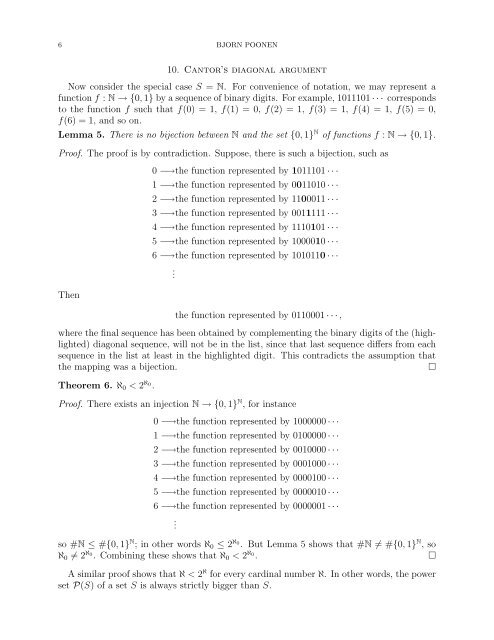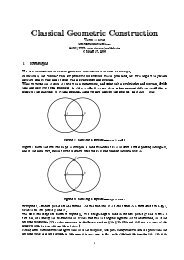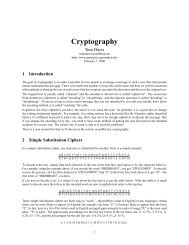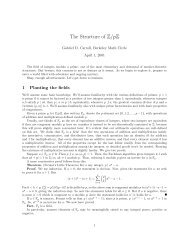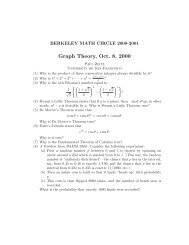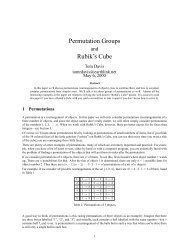INFINITY: CARDINAL NUMBERS 1. Some terminology of set theory ...
INFINITY: CARDINAL NUMBERS 1. Some terminology of set theory ...
INFINITY: CARDINAL NUMBERS 1. Some terminology of set theory ...
You also want an ePaper? Increase the reach of your titles
YUMPU automatically turns print PDFs into web optimized ePapers that Google loves.
6 BJORN POONEN<br />
10. Cantor’s diagonal argument<br />
Now consider the special case S = N. For convenience <strong>of</strong> notation, we may represent a<br />
function f : N → {0, 1} by a sequence <strong>of</strong> binary digits. For example, 1011101 · · · corresponds<br />
to the function f such that f(0) = 1, f(1) = 0, f(2) = 1, f(3) = 1, f(4) = 1, f(5) = 0,<br />
f(6) = 1, and so on.<br />
Lemma 5. There is no bijection between N and the <strong>set</strong> {0, 1} N <strong>of</strong> functions f : N → {0, 1}.<br />
Pro<strong>of</strong>. The pro<strong>of</strong> is by contradiction. Suppose, there is such a bijection, such as<br />
Then<br />
0 −→the function represented by 1011101 · · ·<br />
1 −→the function represented by 0011010 · · ·<br />
2 −→the function represented by 1100011 · · ·<br />
3 −→the function represented by 0011111 · · ·<br />
4 −→the function represented by 1110101 · · ·<br />
5 −→the function represented by 1000010 · · ·<br />
6 −→the function represented by 1010110 · · ·<br />
.<br />
the function represented by 0110001 · · · ,<br />
where the final sequence has been obtained by complementing the binary digits <strong>of</strong> the (highlighted)<br />
diagonal sequence, will not be in the list, since that last sequence differs from each<br />
sequence in the list at least in the highlighted digit. This contradicts the assumption that<br />
the mapping was a bijection. <br />
Theorem 6. ℵ0 < 2 ℵ0 .<br />
Pro<strong>of</strong>. There exists an injection N → {0, 1} N , for instance<br />
0 −→the function represented by 1000000 · · ·<br />
1 −→the function represented by 0100000 · · ·<br />
2 −→the function represented by 0010000 · · ·<br />
3 −→the function represented by 0001000 · · ·<br />
4 −→the function represented by 0000100 · · ·<br />
5 −→the function represented by 0000010 · · ·<br />
6 −→the function represented by 0000001 · · ·<br />
.<br />
so #N ≤ #{0, 1} N ; in other words ℵ0 ≤ 2 ℵ0 . But Lemma 5 shows that #N = #{0, 1} N , so<br />
ℵ0 = 2 ℵ0 . Combining these shows that ℵ0 < 2 ℵ0 . <br />
A similar pro<strong>of</strong> shows that ℵ < 2 ℵ for every cardinal number ℵ. In other words, the power<br />
<strong>set</strong> P(S) <strong>of</strong> a <strong>set</strong> S is always strictly bigger than S.


